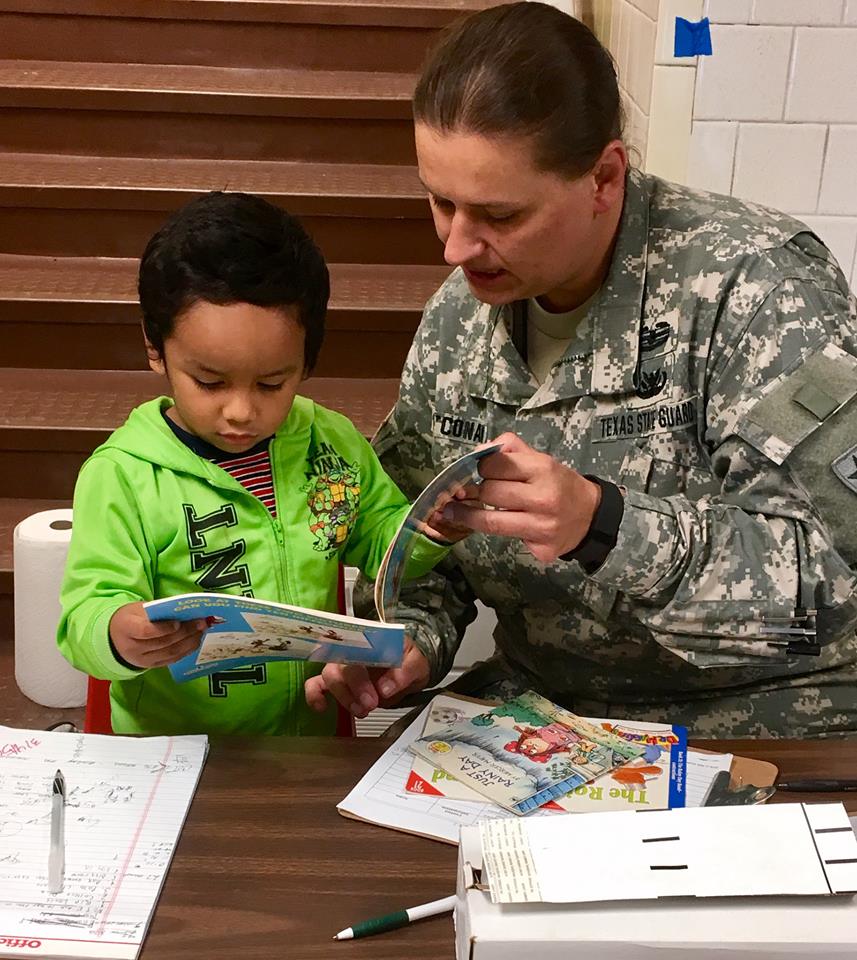 Texas State Guard member entertains the kids at an evacuee shelter in San Antonio
Texas State Guard member entertains the kids at an evacuee shelter in San Antonio
Story by: Chief Warrant Officer 3 Schmelzer
Texas State Guard Public Affairs
Hurricane Harvey was a mammoth Category 4 hurricane and the first major hurricane to make landfall in the United States since 2005. When it hit the Texas Gulf Coast, August 25, 2017, wind speeds reached 130 mph.
Harvey spawned historic levels of rainfall, with some areas of Texas receiving as much as 50-60 inches. Winds and flooding devastated entire neighborhoods, leaving thousands of Texans homeless and causing once-in-a-generation levels of destruction. The situation was dire and required a significant emergency response.
More than 1,000 Texas State Guardsmen from the Army, Air, Medical and Maritime components, as well as chaplains, judge advocates and engineers, responded quickly to assist storm victims.
State Guardsmen receive extensive training in emergency and natural disaster response and brought this training to bear during Hurricane Harvey response efforts, by conducting search and rescue missions, coordinating shelter operations and delivering critical supplies to impacted residents.
“Helping fellow Texans at shelters means thousands of displaced families and individuals will find some comfort in the aftermath of this traumatic event. I am humbled by their resiliency and courage,” said Sgt. 1st Class Thomas Adamowicz, 4th Regiment, Texas State Guard.
Emergency evacuation teams deployed to assist with the statewide Emergency Tracking Network, a process which helps to maintain accountability of evacuees who travel to shelters in designated mass transit vehicles. Using the ETN system, State Guardsmen processed thousands of evacuees, allowing families to travel together to the same shelters, locate relatives and eventually return to their city or town on busses. State Guardsmen also registered family pets, giving many pet owners the peace of mind they would not have to leave their pets behind.
Texas State Guard search and rescue teams, working jointly with local emergency management officials, the Texas National Guard and local fire, rescue and law enforcement agencies, went into flooded neighborhoods to evacuate residents trapped by rising water. Using rescue boats, or in many cases just wading through the floodwaters, State Guardsmen rescued more than 1,300 stranded people and pets, saving countless lives.
As thousands of evacuees went to American Red Cross designated shelters, Texas State Guard members were there to help evacuees find comfort and keep their families together. Guardsmen set up shelters with cots and blankets, dining areas, medical rooms play areas for children and pet kennels.
The Texas State Guard “made me feel relieved about being here amongst the other 3,000 people in this convention center],” wrote an evacuee. “Just because of the Soldiers’ presence, we could sleep and eat so well.”
With the loss of power and water systems, many Texas residents in the hurricane strike zone also needed basic essentials.
The Texas State Guard Engineer Direct Report Unit received a list of water and sewer systems that required daily inspections to determine the quality of the water and the operational status of the sewers.
“The need for clean water in flooded areas, such as Houston, was a dire emergency,” said Capt. Ian Taylor, Engineer Direct Report Unit, Texas State Guard. “
To ease the plight of residents caused by these conditions, State Guardsmen moved pallets of water and packed cleaning kits in American Red Cross warehouses. Manning multiple points of distribution, they handed out food, cases of clean drinking water and bags of ice to hundreds of local residents.
“The Texas State Guard trains extensively for these types of emergencies, which often require a wide array of services, said Capt. Esperanza Meza, 19th Regiment, Texas State Guard. “From search and rescue, to helping our fellow Texans rebuild their lives, the services we provided during Hurricane Harvey meant the communities impacted by this disaster could count on us to be there when they needed us the most.”